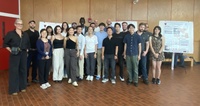Overview
- Mechanical Stress, Cell Shape, and Cell Architecture in Mechanotransduction
- Detection, Characterization and Visualization of Calcium Sparks In Micropatterned Cardiac Myocytes
- Estimation of Contractile Stress on Cardiac Myocytes
Mechanical Stress, Cell Shape, and Cell Architecture In Mechanotransduction
Primary Investigator: Nicholas Geisse, Ph.D
We are investigating the role of the cytoskeleton in the organization and regulation of cellular physiology. We are using several enabling technologies to assist this investigation, including microcontact printing, epifluorescence and confocal microscopy, electrophysiological conduction mapping, electron microscopy, and atomic force microscopy.
Adult myocytes have a characteristic rectangular structure that does not change even when extracted from the whole heart. This structure enhances contractile function of the heart, as the cell generates contractile force along the axis of the sarcomeric actin and perpendicular to the axis of the sarcomere Z-line, which together compose the myofibril. In contrast, neonatal rat cardiac myocytes have a malleable myofibrillar architecture after extraction. Our hypothesis is that structure and organization of the cardiac myocyte cytoskeleton can be influenced by geometrical cues in the extracellular environment. We have cultured neonatal rat myocytes onto geometrically controlled islands of extracellular matrix (see Parker et al. FASEB J 2002). Our results show that in the absence of defined geometrical cues, myofibrils in the neonatal cell assemble in a seemingly random manner. However, in geometries with defined boundary conditions myofibrils assemble based on the edges and corners of their environment. In circular patterns, where edges and corners are absent, these cells lack a regular myofibrillar pattern based on imposed cell geometry.

A: Adult Rat Cardiac Myocyte without structural modification (nucleus not shown).
B: Neonatal Rat Cardiac Myocyte without structural modification, cultured on a monolayer of extracellular matrix protein.
C: Neonatal Rat Cardiac Myocyte cultured on a rectangular island of extracellular matrix protein.
D: Neonatal Rat Cardiac Myocyte cultured on a triangular island of extracellular matrix protein.
E: Neonatal Rat Cardiac Myocyte cultured on a square island of extracellular matrix protein.
F: Neonatal Rat Cardiac Myocyte cultured on a circular island of extracellular matrix protein.
Detection, Characterization and Visualization of Calcium Sparks In Micropatterned Cardiac Myocytes
Primary Investigator: Mark Bray, Ph.D.
The cytoarchitecture of the myocyte has been determined to be critical in understanding not only mechanical contraction of the cell but also electrical propagation. Knowledge of this mechanotransduction mechanism has implications in the treatment of stretch-activated arrhythmias, as well as understanding the role of the extracellular environment on intracellular signaling pathways. Our objective is to micropattern myocytes into various shapes and examine spark occurrence as a function of cell shape. The expectation is that cell shapes which incorporate regions of high mechanical cellular stress will modulate calcium spark characteristics as the cytoskeleton reconfigures itself accordingly. A critical and novel component of this project is the development of software able to detect and visualize sparks in two-dimensions.

Estimation of Contractile Stress on Cardiac Myocytes
Primary Investigator: Poling Kuo, M.D.
We hypothesize that mechanical coupling between cells plays a critical role both in the normal and pathological development of cardiac tissues. We are using traction force microscopy to map the contractile stresses of micropatterned neonatal rat cardiomyocytes.


